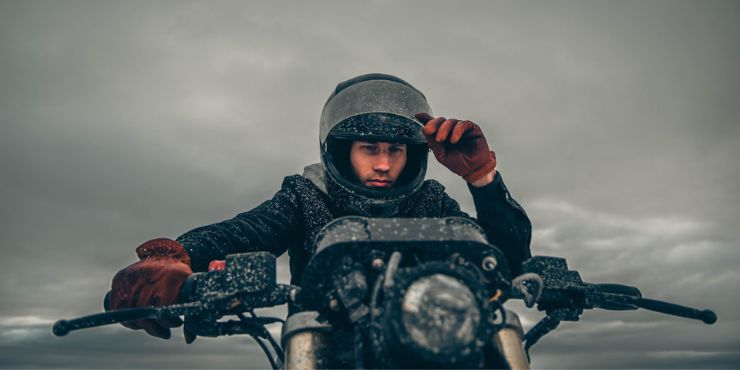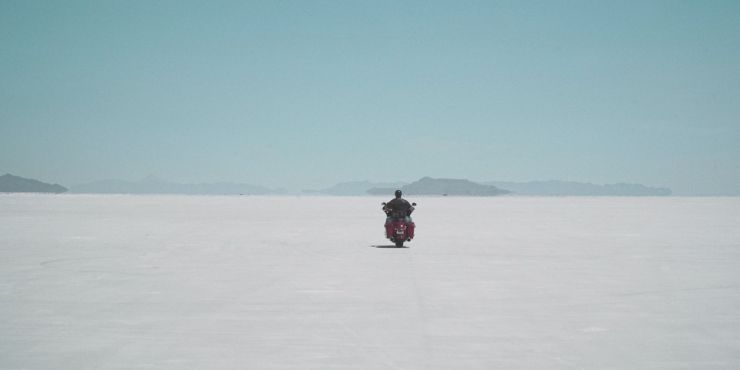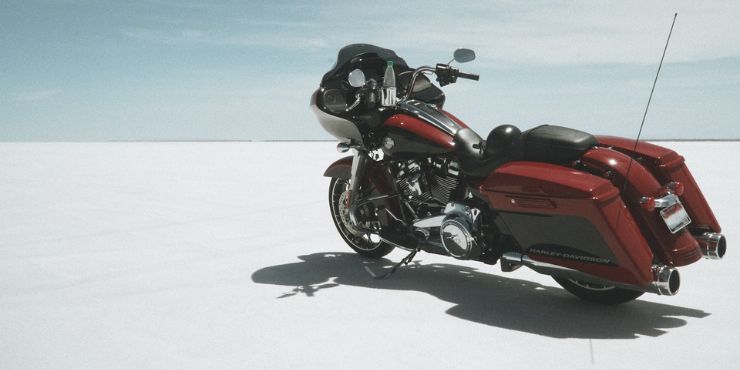Do you live in a region with extreme winter conditions and are concerned about the condition of your Harley-Davidson bike? If so, then don’t worry because here you’ll find out how cold is too cold for your Harley-Davidson bike.
Riding a motorcycle below 32°F (0°C) is generally considered too cold due to risks like ice, reduced tire grip, and loss of rider dexterity. Wind chill can also significantly impact comfort and safety.
In this article, you’ll get to know all about riding your Harley-Davidson bike in cold conditions, how cold is too cold to ride a motorcycle, what is the ideal riding temperature for a Harley-Davidson bike, and important factors to consider when driving your Harley-Davidson bike in extreme cold. Stick around to know all the answers that you’ve been looking for.
How cold is too cold to ride a motorcycle?
If you’ve got a costly Harley-Davidson bike, you wouldn’t want anything to happen to it. Of course, you wouldn’t want to ride it in unsafe temperatures such that your bike gets affected. It’ll be important to know how cold is too cold to ride a motorcycle to prevent any mishaps.
Generally, it isn’t recommended to ride a Harley-Davidson motorcycle when the temperature is below the freezing point (0°C or 32°F). Ice starts forming at such low temperatures, and bikes are highly susceptible to ice as they’re smaller vehicles. If you absolutely need to drive in freezing temperatures, ensure that you’re putting on the proper gear.
Interestingly, most bikers find temperatures between 39°F to 25°F to be a bit too cold for driving their bike. While it is possible to ride in temperatures as low as 10°F, you’ll need to wear proper winter gear at such low temperatures. With that said, some people avoid riding their bikes once the temperature falls below 35°F. The other significant factors include if there’s any risk of snow or ice or if the roads aren’t dry.
Cold temperatures aren’t just highly uncomfortable for riding a Harley-Davidson bike, but they’re also extremely dangerous. As the temperatures start getting low, motorcycle tires start to harden. This makes them less sticky, and they’ll be able to easily lose traction on the road.
What is the ideal temperature for riding a Harley-Davidson motorcycle?
The ideal temperature to ride a Harley-Davidson motorcycle is between 60°F and 80°F. Riding a bike at a temperature in this range will not only be comfortable, but it’ll be enjoyable as well. It’ll offer an exceptional experience, especially when you’re wearing appropriate motorcycle gear.
The temperature ranges that people find most comfortable driving in tends to vary. Some people prefer taking their Harley-Davidson out on a long drive in temperatures as low as 40°F. Meanwhile, others might deem 50°F to be too cold for their liking. On the other hand, some bikers don’t mind driving in temperatures that are as high as 100°F. Although, some riders consider even 90°F to be too warm. Generally, temperatures between 40°F and 80°F are considered to be a decent range for driving your Harley-Davidson bike. 70°F is unofficially believed to be the best temperature as most bikers feel most comfortable here.
The temperature outside will certainly have a say on what gear a Harley-Davidson rider wears. Below 50°F, some riders might feel the need to put on their winter gear, which isn’t exactly as comfortable and enjoyable as the summer gear. The quality of your gear will also affect how bearable the different temperature points will be.
Humidity has a major say in when it feels warm enough to drive outdoors, or when is it too warm. Generally, most people find humidity levels of 55 or less to be comfortable. At humidity levels of 75 or above, riding a Harley-Davidson bike can start to become a rather unpleasant experience. For instance, even brief stops at red lights could become very uncomfortable and frustrating. While riding, depending on the ambient temperature, the riders can feel a bit more comfortable. However, sweating can be a major issue. As the humidity starts reaching 100, air moisture becomes too oppressive for most people. It’ll be even worse when it’s combined with hot weather.
Important factors to consider when driving your bike in extremely cold weather
Driving your Harley-Davidson bike during winter has its own set of hazards. It requires a lot of planning, preparation, and a keen sense of road and weather conditions. With that said, there are certain important factors that you need to remember when you are driving in cold weather.
Understand the risks of driving in extremely cold weather
Being a safe driver depends on your training, skills, knowledge, equipment, and risk management. While many view riding bikes as a physically low-impact activity, it actually requires a reasonable level of strength and fitness. Driving your Harley-Davidson bike in winter will require you to carefully consider the risk vs. benefit assessment before you decide. It’s important to look at the riding risks that you’ll have to manage when driving in extreme cold.

Speed you’re driving at
During winter, you’ll have to drive your Harley-Davidson bike at lower speeds. Reduced speed will give you a lot more time to respond to traffic and the hazards in front of you. Another benefit of riding slower would be reducing the stopping distance, especially when traction is a bigger issue in winter.
Following distance
The general rule for following distance happens to be 2-3 seconds. It works in summer for attentive riders. In winter, you should consider increasing the distance. You must remember that you check your mirror frequently for tailgaters. Your reaction time will be generally slower in the cold. Moreover, other road users can react more suddenly or erratically when they experience loss of traction or traffic issues.
Road conditions
Surface hazards tend to increase dramatically in winter. It has been proven that motorcycle collisions depend heavily on the weather. During winter, black ice forms, and it is almost impossible to see until you’re practically on it. Black ice should be expected anywhere the road surface might be near or below freezing point.
Morning frost, while being more visible, will still be very slick. Avoid frost, ice, and places that are more likely to have black ice. Sand, road salt, or cinder can easily accumulate and be slippery, causing you to lose traction. Because of the temperature changes, potholes can develop alongside frost heaves. Moreover, snowplows could catch on the road, which causes edge traps and debris.
Visibility on the road
This can be broken down into two different functional aspects.
Seeing – Being able to see as far ahead as possible will help you manage any surface hazards. Moreover, it’ll prevent potential accidents due to sudden changes in traffic and traction. Seeing potential hazards sooner will allow you more time to avoid them or halt your bike if needed.
Being seen – If you feel invisible to other drivers in the summer, expect it to increase tremendously in the winter. One of the last things that truck and car drivers expect to see in winter is someone driving a motorcycle. Wearing black color or dark riding color will make you blend with the winter scenery. This is contrary to the belief that dark colors stand out against snow because they don’t. Wearing brightly colored and reflective gear will help you with the problem of being invisible to other road users.
Use appropriate winter motorcycle gear
Improving your Harley-Davidson bike helps in keeping you safe when riding during extremely cold weather. There are certain pieces of gear that you should consider during the winter –
Winter motorcycle tires
For driving cars in the winter, you can find studded tires and a wide variety of winter-rated tires and all-season radials. For motorcycles, it’s an entirely different story. While there are winter or snow tires made globally, they’re rarely available in the US and come in limited sizes. Studded tires for ice racing are readily available, but they aren’t street worthy. There’s both good and bad news when using winter motorcycle tires. The good news for you is that the thread compound has been designed to be sticky below even 40°F. The bad news is that above 40°F, they’ll be less effective than normal tires, while they also deteriorate rapidly.
Windshield for bike
Windshields can do a long way in keeping the frigid wind off your body. In case you own a touring bike, you’ll most likely have one already. If you don’t, there is a wide range of aftermarket windshields available in the market for different types of motorcycles.
Handlebar-mounted thermometer
Checking the ambient temperature when riding in the winter will be a great way of maintaining awareness of the hypothermia and frostbite risk. Moreover, you should remember that you factor in wind chill. Thermometers will be helpful all year long as well.
Avoid riding a Harley-Davidson bike in snowy conditions
During winter, it’s a fairly common question if you can ride a Harley-Davidson bike in the snow. While there are certain exceptions like trail riding on specially prepared motorcycles, the simple answer is no. Accelerating, leaning to turn and braking will require tradition. It is provided by two small contact patches present in the motorcycle. Snow, even in small accumulations, can easily zero out the traction.
Additionally, falling snow could rapidly cover your face shield and windshield (if your bike has got one). This can easily leave you visibly compromised. If there’s even a slight possibility of snowfall in your area, and you’re planning to go out, just stay home. After a snowfall, wait for a while so that the roads get cleared. Moreover, consider taking a car out for a reconnaissance drive before you take your Harley-Davidson out for a drive.
Check the temperature and weather forecast before riding your Harley-Davidson bike
Even when you feel the skies are clear and there’s no snow or other winter precipitation, you should be alert. It’s normal to contend with cold temperatures, as they make winter riding unique. At such a time, riders generally wonder how cold is too cold to ride a motorcycle. It’s important to check the weather forecast to ensure that the temperature isn’t too cold. Here are a few issues you might have if you drive in temperatures that are too cold.
Wind chill on the bike
The wind chill is essentially the effect of rapidly moving air reducing the felt temperature and its impact upon you. What felt like a rather warm winter day while standing in your garden could feel significantly colder on the road.
Hypothermia
If you’re exposed to subfreezing temperatures, you’ll be at risk of developing hypothermia. This life-threatening condition can occur if your body’s core temperature ends up falling below 95°F. There are certain early signs of hypothermia that you should be aware of. Some common ones include shivering uncontrollably, mental confusion, feeling numb and weak, loss of consciousness, and reduction of fine motor control.
Wear clothing for cold weather
Wearing all the necessary gear for any ride will be best for your safety. This is especially true if you’re riding in extremely cold conditions. You’ll have two primary goals when choosing and wearing clothes during extremely cold weather. The first goal would be to maintain core temperature to help you avoid hypothermia. The second goal will be to keep any extremities from exposure to cold air.

Winter motorcycle gloves
Winter-rated gloves will be an absolute necessity if you want to protect your hands from freezing cold. They should block the wind and have proper insulation to hold in warmth. It is essentially a balancing act to find warm gloves that feel good at the controls. You should consider using electric gloves capable of plugging into your motorcycle’s electrical system. You shouldn’t just assume that heated grips can replace the need for winter riding gloves.
Helmet with face shield
Your eyes and face need to be protected from the cold blast of winter wind. Your vision will be the most powerful tool when it comes to managing the hazards faced during a winter ride. The skin on your face is extremely delicate, and it can develop frostbite quickly, especially in your ears and nose.
Layering of the bike
Always layer cold-weather motorcycle clothing and avoid any gaps where the layers overlap. Make use of a base layer that can wick away sweat. Riders still sweat during the winter, which makes you feel cold faster. Next, you should include a street layer that you’re comfortable removing at rest stops. If you’re using electric riding gear, put it on under an insulating layer and over the street layer. Lastly, you should put on a layer that offers crash protection and stops the wind.
Conclusion
Thank you for reading. Hopefully, now you know a lot more about riding your Harley-Davidson bike in cold conditions, how cold is too cold to ride a motorcycle, what is the ideal riding temperature for a Harley-Davidson bike, and important factors to consider when driving your Harley-Davidson bike in extreme cold. A common question that arises among Harley-Davidson riders, especially during winter, is how cold is too cold to ride a motorcycle. With such a costly bike, you wouldn’t want to damage it by using it in improper conditions. Generally, it isn’t recommended to ride a Harley-Davidson bike when the temperature is below the freezing point (0°C or 32°F).

